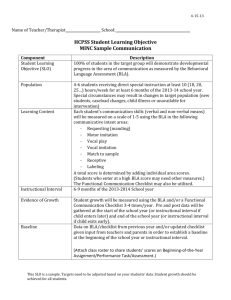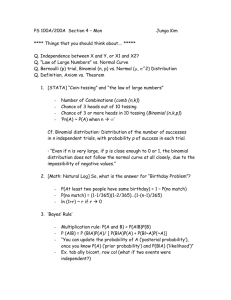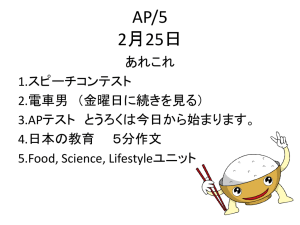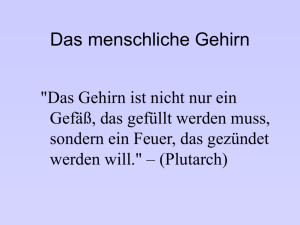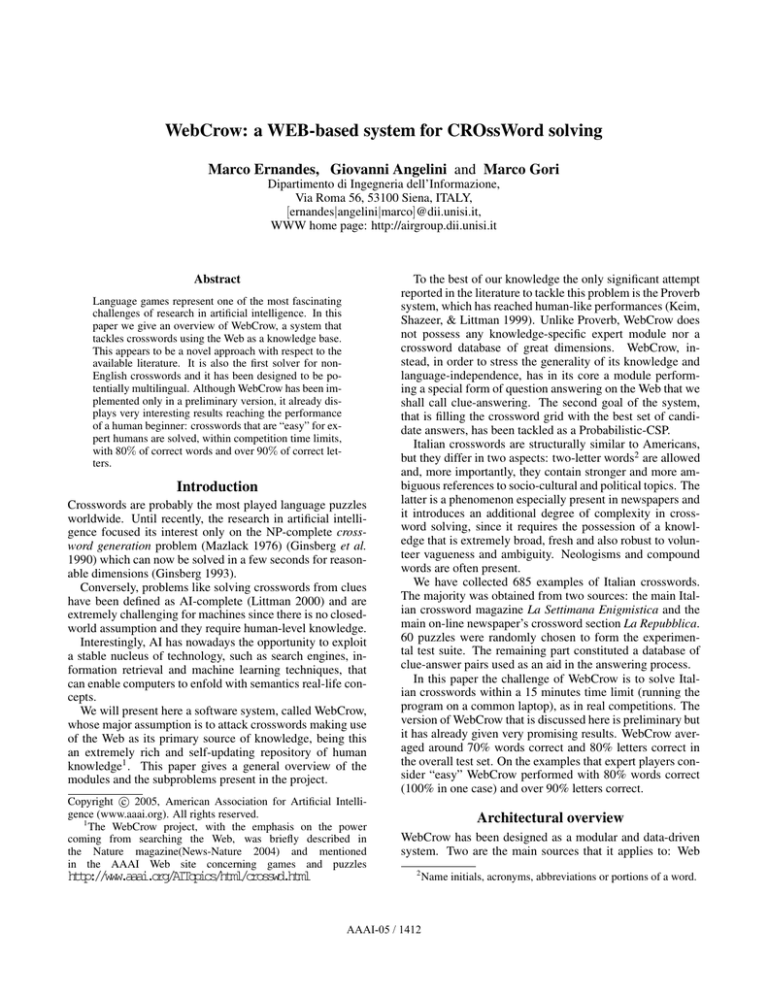
WebCrow: a WEB-based system for CROssWord solving
Marco Ernandes, Giovanni Angelini and Marco Gori
Dipartimento di Ingegneria dell’Informazione,
Via Roma 56, 53100 Siena, ITALY,
[ernandes|angelini|marco]@dii.unisi.it,
WWW home page: http://airgroup.dii.unisi.it
Abstract
Language games represent one of the most fascinating
challenges of research in artificial intelligence. In this
paper we give an overview of WebCrow, a system that
tackles crosswords using the Web as a knowledge base.
This appears to be a novel approach with respect to the
available literature. It is also the first solver for nonEnglish crosswords and it has been designed to be potentially multilingual. Although WebCrow has been implemented only in a preliminary version, it already displays very interesting results reaching the performance
of a human beginner: crosswords that are “easy” for expert humans are solved, within competition time limits,
with 80% of correct words and over 90% of correct letters.
Introduction
Crosswords are probably the most played language puzzles
worldwide. Until recently, the research in artificial intelligence focused its interest only on the NP-complete crossword generation problem (Mazlack 1976) (Ginsberg et al.
1990) which can now be solved in a few seconds for reasonable dimensions (Ginsberg 1993).
Conversely, problems like solving crosswords from clues
have been defined as AI-complete (Littman 2000) and are
extremely challenging for machines since there is no closedworld assumption and they require human-level knowledge.
Interestingly, AI has nowadays the opportunity to exploit
a stable nucleus of technology, such as search engines, information retrieval and machine learning techniques, that
can enable computers to enfold with semantics real-life concepts.
We will present here a software system, called WebCrow,
whose major assumption is to attack crosswords making use
of the Web as its primary source of knowledge, being this
an extremely rich and self-updating repository of human
knowledge1 . This paper gives a general overview of the
modules and the subproblems present in the project.
c 2005, American Association for Artificial IntelliCopyright gence (www.aaai.org). All rights reserved.
1
The WebCrow project, with the emphasis on the power
coming from searching the Web, was briefly described in
the Nature magazine(News-Nature 2004) and mentioned
in the AAAI Web site concerning games and puzzles
http://www.aaai.org/AITopics/html/crosswd.html
To the best of our knowledge the only significant attempt
reported in the literature to tackle this problem is the Proverb
system, which has reached human-like performances (Keim,
Shazeer, & Littman 1999). Unlike Proverb, WebCrow does
not possess any knowledge-specific expert module nor a
crossword database of great dimensions. WebCrow, instead, in order to stress the generality of its knowledge and
language-independence, has in its core a module performing a special form of question answering on the Web that we
shall call clue-answering. The second goal of the system,
that is filling the crossword grid with the best set of candidate answers, has been tackled as a Probabilistic-CSP.
Italian crosswords are structurally similar to Americans,
but they differ in two aspects: two-letter words2 are allowed
and, more importantly, they contain stronger and more ambiguous references to socio-cultural and political topics. The
latter is a phenomenon especially present in newspapers and
it introduces an additional degree of complexity in crossword solving, since it requires the possession of a knowledge that is extremely broad, fresh and also robust to volunteer vagueness and ambiguity. Neologisms and compound
words are often present.
We have collected 685 examples of Italian crosswords.
The majority was obtained from two sources: the main Italian crossword magazine La Settimana Enigmistica and the
main on-line newspaper’s crossword section La Repubblica.
60 puzzles were randomly chosen to form the experimental test suite. The remaining part constituted a database of
clue-answer pairs used as an aid in the answering process.
In this paper the challenge of WebCrow is to solve Italian crosswords within a 15 minutes time limit (running the
program on a common laptop), as in real competitions. The
version of WebCrow that is discussed here is preliminary but
it has already given very promising results. WebCrow averaged around 70% words correct and 80% letters correct in
the overall test set. On the examples that expert players consider “easy” WebCrow performed with 80% words correct
(100% in one case) and over 90% letters correct.
Architectural overview
WebCrow has been designed as a modular and data-driven
system. Two are the main sources that it applies to: Web
2
Name initials, acronyms, abbreviations or portions of a word.
AAAI-05 / 1412
INPUT
clue
Implicit Module
Statistical Filter
TF_IDF + Clue/Answer
distance
crossword grid
1. bla bla
2. bla bla bla bla
3. bla bla bla bla bla bla
4. bla bla
8. bla bla bla bla
11. bla bla bla bla bla bla bla
15. bla bla bla bla bla
16. bla
21. bla bla bla bla
26. bla bla
29. bla bla bla bla bla bla
1. bla
2. bla bla
3. bla bla bla
4. bla bla la bla bla bla bla
8. bla bla bla bla
11. bla bla bla bla
15. bla bla
16. bla bla bla bla bla bla bla
21. bla bla
26. bla bla
29. bla bla bla bla
text
CSP
Solver
clues
clues
DataBase
Modules
merged
candidate
lists
Rule-based
Modules
Merger
Coordinator
Dictionary
Modules
WebSearch
Module
List Generators
candidates
Web Search List Generator
s
f
t
l
s
f
i
i
s
i
OUTPUT
u p e r
r a g
c e
i d o
u p e r
r a g
c e
x
d
o c
u p e
f r a
i
i
x
c
c
i
p
i
r
g
c a l
l i
p
i
i o
a l
l i s
i a
u
o
c a
i l i
i
s
a
u
i
t
l
s
l
s
Query queries Document
Retrieval
Expansion
(SE&WEB)
clue
INPUT
Text & Candidate Candidate
Weighting
Extraction
Morphological Filter
candidate
lists
tags
Statistical Filter
docs
clue
Clue
MorfoClassifier
Morpho Filter
filtered
candidates
filtered
text candidates candidates
PoS Tagger
class confidences
tags
Confidence
Estimator
candidate list
OUTPUT
Tag Filter
List Filters
(A) General Overview
(B) The Web Search Module
Figure 1: (A) A general overview of WebCrow’s architecture (inspired by Proverb’s). (B) A sketch of the internal architecture of the Web
Search Module, with its three main submodules: the web-based list generator, the statistical and the morphological list filter.
documents and previously solved crosswords. It is also possible to plug in additional ad hoc information (i.e. word
play rules) in order to increase the system’s performances.
We designed WebCrow’s architecture (fig. 1A) using some
insights from Proverb’s. The information flow is similar: in a first phase the clues are analyzed by a set of
candidate-list generators (the expert modules). Among
these the preliminary role is played by the Web Search
Module (WSM). Each list contains a global confidence
score and a set of words ordered by probability. These
candidate lists are passed to a merger system that produces a unique list for each clue. In a second phase, a
constraint-satisfaction algorithm carries forward the gridfilling, in order to place the correct words within the slots.
In addition to the list generators we
clue
introduce here the concept of list filter.
This sort of expert module takes as an
input a clue and a candidate list, and
List Filter
returns a new candidate list filtered by
inner filtered list
clue
logic
some specific logic or knowledge. Filtercandidate
ing includes re-ranking or deletion of the
list
candidates and re-weighting of the confidence score associated to the list.
At the current stage we implemented a statistical filter,
based on IR techniques, and a morphological filter, based
on machine learning and NLP techniques. These have been
embedded in the WSM. Our future objective is to implement
a full battery of filters: stylistic, morpho-syntactical, lexical
and logical.
List Generator
inner
candidate list
sources
& logic
The web-search module (WSM)
sibly, often becoming more challenging than classic QA3 .
The main differences are:
• clues are mostly formulated in a non-interrogative form (i.e:
≺La voce narrante del Nome della Rosa: adso4 ) making the
task of determining the answer-type more subtle.
• clues can be voluntarily ambiguous and misleading (i.e:
≺Quello liquido non attacca: scotch5 )
• the topic of the questions can be both factoid6 and non-factoid
(i.e: ≺Ci si va al buio: cinema7 )
• there is a unique and precise correct answer: a single or a compound word (i.e. ≺Vi si elegge il papa: cappellasistina8 ),
whereas in QA the answers are usually a 50/250-byte-passage
in which the target has to be recognizable by humans.
• the list of candidate answers requires also a global confidence
score, expressing the probability that the target is within the list.
The only evident advantage in crossword solving is that
we priorly know the exact length of the words that we are
seeking. We believe that, thanks to this property, web search
can be extremely effective.
The inner architecture of the WSM is sketched in figure 1B. It is based on three main sub-modules: a web-based
list generator that extracts possible answers to a clue from
web documents by picking the terms (and compound words)
of the correct length, a statistical filter that ranks the candidates using statistical information retrieval techniques and a
morphological filter that ranks the words according to their
morphological category. The confidence estimator at the
back end of the module has been implemented by a multilayer neural network. It was trained on a set of 2000 candidate lists, to associate confidence scores to the lists.
3
The Web Search Module represents the heart of WebCrow
and the main innovation with respect to the literature.
The goal of this important module recalls that of a Webbased Question Answering system. The idea is to exploit the
Web and search engines (SE) in order to find sensible answers to questions expressed in natural language. However,
with crossword clues, the nature of the problem changes sen-
The main reference for standard QA is the TREC competition (Voorhees & Tice 2000).
4
≺The background narrator of the Name of the Rose: adso
5
≺The liquid one does not stick: scotch, the clue ambiguously refers to two different senses: scotch-whisky and scotch-tape.
6
As TREC questions, like Who was the first American in space?
7
≺We go there in the darkness: cinema
8
≺Where the Pope is elected: cappellasistina
AAAI-05 / 1413
Module
WSM
CWDB-EXACT
CWDB-PARTIAL
CWDB-DICTIO
RULE-BASED
DICTIONARY
ALL BUT WSM
ALL
Cover
68.1
19.8
29.0
71.1
10.1
97.5
98.4
99.3
1-pos
13.5
19.6
10.6
0.4
6.9
0.3
34.0
36.5
5-pos
23.7
19.8
20.1
2.1
8.3
1.6
43.6
50.4
100-pos
53.2
19.8
28.4
21.5
10.1
21.3
52.3
72.1
Len
499
1.1
45.5
>103
12.4
>104
>104
>104
Table 1: Cover (coverage) reports the frequency with which the
target word can be found within the candidate list. 1-pos gives the
freq. of the target in first position, 5-pos the freq. within the first
five candidates, 100-pos within the first hundred. Len is the avg.
list length. The WSM used a maximum of 30 documents per clue.
Test Set: 60 crosswords (3685 clues).
Although the current design and implementation of the
WSM are only at an initial stage, this is already able to produce impressive answering performances. It is in fact the
module that provides the best coverage/precision balance, as
it can be observed in tab. 1. In over half of cases the correct
answer can be found within the first 100 candidates within
a list containing more than 104 words. The contribution of
the WSM can be appreciated in the last two rows of tab. 1
where we observe the loss of performance of the whole system when the WSM is removed. The overall coverage of
the system is mainly guaranteed by the Dictionary module,
but the introduction of the WSM is fundamental to increase
sensibly the rank of the correct answer. Interesting results
are reported in fig. 2, where we take into account the length
of the target. It can easily be observed that the WSM guarantees very good performances even with long word targets,
which are of great importance in the CSP phase.
As it can be seen in table 2 the coverage of the WSM’s
lists grows sensibly incrementing the number of retrieved
documents. This contribution is imperceptible after 100
docs. An optimal balance in the trade off between precision,
coverage and time cost is reached using 30 docs. We took
this as the quantity of sources to be used in the experiments
because it allows to fulfill the time limit of 15 minutes.
Seeking answer candidates
Retrieving the documents The first goal of the answering process is to retrieve the documents that are better related
to the clue. This can be done thanks to the contribution of
search engine’s technology (GoogleTM was used in our testing). In order to increase the informativeness of the search
engine the clues go through a reformulation/expansion step.
Each clue C={t1 t2 ...tn } generates a maximum of 3 queries:
Q1 =< t1 ∧ t2 ∧ ...tn >, Q2 =< t1 ∨ t2 ∨ ...tn > and
Q3 =< (t11 ∨ t21 ∨ ...) ∧ (t12 ∨ t22 ∨ ...) ∧ ...(t1n ∨ t2n ∨ ...) >
where tin is the i-th derivation (i.e. changing the number, the
gender, ...) of term tn . Q3 has not been implemented yet.
A classic QA approach is to make use only of the snippets
in order to stress time efficiency. The properties of the clues
sensibly reduce the probability of finding the answer within
a snippet and we decided for a full-document approach.
The SE interrogation and the successive downloads are
Figure 2: The frequency of the target in first position (left) and
within the first 100 candidates (right) related to its word length.
The black curve represents the overall performance of the system,
the gray curve reports the results of the system without the WSM.
the most time consuming tasks of the clue-answering process. Therefore we implemented them in a highly parallel
manner, similarly to web-crawlers, making tens of contemporary http requests with short time-outs.
For each example of our test suite we have produced a
full retrieval session with a maximum of 200 docs per clue
(max. 30 docs with Q2 ). 615589 docs were downloaded
in 44h 36min (bandwidth: 1Mb/s, effective ≈100KB/sec,
avg. 230 docs/min, 167 docs/clue, 25.6KB/doc). All the test
sessions were subsequently made offline exploiting this web
image.
Extracting useful text The extraction of the text goes
through two different steps. Primarily, the documents are
processed by a parser that converts them to plain text. Secondarily this text is passed to a list generator that extracts
the words of the correct length and produces an unweighted
candidate list. Both outputs are then passed to the statistical
and morphological list filter.
Ranking of the candidates The candidates are ranked
exploiting the information provided by the two list filters.
The score associated to each word candidate w is given by
p(w, C) = c (sf -score(w, C) × mf -score(w, C))
(1)
where sf -score(w, C) is the score attributed to word w by
the statistical filter, mf -score(w, C) is the score provided
by the morphological filter, c is thePnormalizing factor that
n
fulfills the probability requirement i=0 p(wn , C) = 1.
In QA systems it is important to produce very high precision only in the very first (3-5) answer candidates, since a
human user will not look further down in the list. For this
reason NLP techniques are typically used to remove those
answers that are not likely correct. This answer selection
policy is not well suited for clue-answering. A more conservative approach is required because the lack of the correct
answer makes a greater damage than a low precision. The
eq. 1 serves this goal: words that have low scores will appear
at the bottom of the list but will not be dropped.
Statistical filtering
A score is associated to each triple (w, Qn , Di ), where w
is a word belonging to the document Di given as output
to the query Qn (n-th reformulation of clue C). A rank
rank(Di , Qn ) is given to each document provided by the
AAAI-05 / 1414
Cover
46.4
56.2
63.7
67.9
71.6
74.5
68.1
71.7
WSM(5)+SF
WSM(10)+SF
WSM(20)+SF
WSM(30)+SF
WSM(50)+SF
WSM(100)+SF
WSM(30)+SF+MF
WSM(50)+SF+MF
1-pos
11.1
12.2
12.3
12.3
12.2
11.9
13.5
13.6
5-pos
19.1
21.6
22.1
22.2
22.0
21.5
23.7
24.0
100-pos
41.7
47.5
50.3
52.3
53.4
53.2
53.2
54.1
Time
1:25
2:45
5:30
8:10
13:30
26:50
8:45
14:15
Table 2:
The performances of the WSM. The number of
documents used is reported in brackets. SF=statistical filter,
MF=morphological filter. Time is reported in min:secs.
search engine (SE) using the query Qn . Finally, the global
score of a word extracted by the documents using the query
Qn is given by the weighted sum showed below:
sf -score(w, Qn ) =
#docs
X score(w, Qn , Di )
rank(Di , Qn )
length(Di )
i=0
(2)
where length(Di ) is the number of words in Di . The score
of a word within a single document is computed in a TFIDF fashion. TF has been modified in order to take into account the inner-document distance between the word and the
query. Each occurrence of a word counts 1/dist(w, Q, Di ),
whereas in normal TF each occurrence counts equally:
score(w, Q, Di ) = idf (w)
X
occ(w)∈Di
1
dist(w, Q, Di )
(3)
occ(w) ∈ Di represents all the occurrences of the word w in
the document Di . The distance between word w and query
Q (eq. 4) is computed as the square-root-mean distance between w and each term wQt of the query. To enhance the
relevance of the words that are close to the more informative
terms in the query we tune the exponential factor with the
between 1 and 3).
idf value of wQt (normalized
q
dist(w, Q, Di ) =
P#terms ∈ Q
t=0
(dist(w, wQt , Di ))idf (wQt )
#terms ∈ Q
(4)
dist(w, wQt , Di ) is given by the minimum number of
words separating w and wQt in document Di . Eq. 4 is a
slightly different version of the distance measure presented
in (Kwok, Etzioni, & Weld 2001) that resulted experimentally more effective for our goals.
Morphological filtering
The module is based on two different parts: a part-of-speech
(PoS) tagger and a clue-classifier. The first one associates a
morphological class to each word of a sentence, while the
second one determines, for each clue, the most probable
morphological classes of the answer. During the filtering
process each document is tagged using the PoS tagger and
the clues are classified by the morpho-classifier. For each
word of the candidate list the following morphological score
is given:
mf -score(w, C) =
#tags
X
p(tagi |w)score(tagi , C)
(5)
i=0
p(tagi |w) is the information provided by the PoS-Tagger,
score(tagi , C) is computed using the output of the classifier
with the addition of a spread factor in order to enhance the
impact of the classification.
With the attempt to maintain a strong languageindependence we chose an automatic trainable PoS tagger,
called TreeTagger (Schmid 1995). We used 26 different
classes to distinguish: articles, nouns and adjectives, verbs,
adverbs, particles, interlocutory words, numbers and others.
The clue classifier was built using multi-class Kernelbased Vector Machine (Tsochantaridis et al. 2004) (Crammer & Singer 2002). A set of about 7000 clue-tag pair was
extracted from the CWDB and tagged by the TreeTagger.
Each example was then automatically mapped to a feature
vector x̄ ∈ Rn and a class i ∈ {1, . . . , k} was associated
to it. The features extracted from each clue-answer pair are:
the length of the target, the number of words in the clue, the
number of capital letters in the clue, a set of the 250 most
frequent clue-words and the probability tag vector associated to each word of the clue. We made use of 21 different
target classes (almost all the morphological ones).
The multi-class Kernel-based Vector Machine learns a linear function H:X→Y of the type H(x̄, M )=hM, Φ(x̄)i=ȳ,
where the predicted class is given by the function
f (x̄)=argmaxi∈{1,...,k} Hi (x̄, M ). Hi (x̄, M )=yi is the i-th
entry of the vector ȳ=H(x̄, M ), corresponding to the score
given to the class i.
Using a cross validation test over the training set described above, we obtain with a linear kernel an accuracy
of 54.3% on the predicted class and a coverage of 91.38%
on the first five predicted classes. If we consider the great
number of different target classes this can be considered as
a remarkable result, which turns out to increase sensibly the
WSM’s performance.
The other modules
The data-base modules (CWDB) Three different DBbased modules have been implemented in order to exploit
the 42973 clue-answer pairs provided by our crossword
database. As a useful comparison, the CWDB used by
Proverb contained around 3.5×105 clue-answer pairs.
CWDB-EXACT simply checks for an exact clue correspondence in the clue-entries. For each answer to a
clue C the score-probability is computed using the number of occurrences in the record C. CWDB-PARTIAL employs MySQL’s partial-match functions, query expansion
and positional term distances to compute clue-similarity
scores. The number of answer occurrences and the cluesimilarity score are used to calculate the candidate probabilities. CWDB-DICTIO simply returns the full list of words
with the correct length, using the number of total occurrences to rank the candidates. Finally, the confidence estimation of the CWDB lists is an entropy function based on
the probabilities and occurrences of the candidates.
The rule-based module (RBM) Italian crosswords often contain a limited set of answers that have no semantic
relation with their clues, but that are cryptically hidden inside the clue itself. This occurs in two-letter and three-letter
answers. The RBM has been especially designed to handle
AAAI-05 / 1415
these cases. We have defined eighteen rules for two-letter
words and five rules for the three-letter case.
For example, with a clue like ≺Ai confini del mondo:
mo9 the RBM works as follows: pattern → ai confini; object → mondo; rule → extract first and last letter from the
object. Hence, answer → mo.
The implicit module The goal of the implicit module is
to give a score to sequences of letters. The implicit module
is used in two ways: first, within the grid-filling algorithm,
to guarantee that the slots that have no candidate words left
during the solving process are filled with the most probable
sequence of characters; second, as a list filter to rank the
terms of the dictionaries. To do so we used tetragrams. The
global score of a letter sequence results by the product of all
the inner tetragram probabilities. Following a data-driven
approach the tetragram probabilities were computed from
the CWDB answers.
The dictionary module Dictionaries will never contain
all the possible answers, being crosswords open to neologisms, acronyms, proper names and colloquial expressions.
Nevertheless these sources can help to increment the global
coverage of the clue-answering. We made use of two Italian
dictionaries respectively containing word lemmas and word
forms. The output of this module is given by the list of terms
with the correct length, ranked by the implicit module.
The Merger The merger module has been implemented
in a very straightforward way.P
The final score of each term
m
w is computed as: p(w) = c i=0 (pi (w) × confi ) where
m is the number of modules used, confi is the confidence
evaluation of module i, pi (w) is the probability score given
by module i and c is a normalizing factor.
The grid-filling
As demonstrated by (Shazeer, Keim, & Littman 1999)
crossword solving can be successfully formalized as a
Probabilistic-CSP problem. In this framework the slots of
the puzzle represent the set of variables and the lists of candidates provide the domain of legal values for the variables.
The goal is to assign a word to each slot in order to maximize the similarity between the final configuration and the
target (defined by the crossword designer). This similarity
can be computed in various ways. We adopted the maximum probability function10 , which means that
Qnwe search
for the complete assignment that maximizes i=1 pxi (vi )
where pxi (vi ) is the probability that the value vi is assigned
to the variable xi in the target configuration.
Finding the maximum probability solution can be faced
using heuristic search techniques as A∗ . Due to the competition time restrictions and to the complexity of the problem
the use of standard A∗ was discarded. For this reason we
adopted as a solving algorithm a CSP version of WA∗ (Pohl
9
≺At the edge of the world: wd, wd is the fusion of the first
and the last letter of object world.
10
A more efficient metric, the maximum expected overlap function , has been proposed in (Shazeer, Keim, & Littman 1999). We
will include this feature in our further works.
#Letters
#Blanks
#Clues
Answer Length
Target in 1-pos
1
Tord
160.7
69.4
59.7
4.99
40.3%
1
Tdif
229.5
37.5
79.5
5.53
37.3%
2
Tnew
156.6
29.8
59.5
5.04
37.3%
2
Told
141.1
31.3
61.4
4.96
33.3%
T3
168.5
37.8
50.5
4.61
31.2%
Table 3: Statistics of the test subsets.
1970). The following cost function was used:
f (X) = γ(dX )(g(X) + wh(X))
(6)
where the path cost is
i=1 -log(pxi (vi )), the heuristic
P
#D
estimation is qj=1 -log(argmaxk=1j (pxj (vjk )) and w is the
weighting constant that makes A∗ more greedy, as in the
classic definition of WA∗ . γ(dX ) represents an additional
score, based on the number of assigned values dX (the depth
of the current node), that makes the algorithm more depthfirst, which is preferable in a CSP framework. This depth
score increases the speed of the grid-filling, but it also causes
f (X) to be non-admissible.
The grid-filling module works together with the implicit
module in order to overcome the missing of a word within
the candidate list. Whenever a variable xi remains with no
available values then a heuristic score is computed by taking
the tetragram probability of the pattern present in xi . The
same technique is used when a slot is indirectly filled with a
term that is not present within the initial candidate list.
Pd
Experimental results
The whole crossword collection has been partitioned in five
subsets. The first two belong to La Settimana Enigmistica,
1
containing examples of ordinary difficulty (mainly
Sord
1
comtaken from the cover pages of the magazine) and Sdif
posed by crosswords especially designed for skilled cruciverbalists. An other couple of subsets belong to La Re2
2
pubblica, Snew
and Sold
respectively containing crosswords
that were published in 2004 and in 2001-2003. Finally, S 3
is a miscellaneous of examples from crossword-specialized
web sites.
Sixty crosswords (3685 clues, avg. 61.4 each) were randomly extracted from these subsets in order to form the ex1
1
perimental test suite: Tord
(15 examples), Tdif
(10 exs.),
2
2
3
Tnew (15 exs.), Told (10 exs.) and T (10 exs.). Some statistics about the test set are shown in table 3. To securely
maintain WebCrow within the 15 minutes time limit
we decided to gather a maximum of 30 documents per
clue. To download the documents, parse them and compute the statistical filtering an average of 8 minutes are
required (tab. 2). An additional 35 secs are needed by
the morphological filter. Thus, in less than 9 minutes
WSM’s work is completed. The other modules are much
faster and the global list generation phase can be terminated in less than 10 minutes. To fulfill the competition
requirements we limited the grid-filling execution time
to 5 minutes. If a complete solution is not found within
this time limit the best partial assignment is returned.
AAAI-05 / 1416
and growth of the Web makes possible to reach better
performance on crosswords containing clues on recent
events. The system discussed here is basic but it has
given very promising results which can be easily improved. The WebCrow architecture is conceived in such
a way that ad hoc modules can be plugged to increase
the performance. We believe that for similar multilingual games, it can become a serious competitor even for
human experts.
Acknowledgments
Figure 3: WebCrow’s performance on the five subsets. The average and the variance of the correct words are also reported.
The results11 that we obtained indicated the different
difficulty inherent in the five subsets. Figure 3 reports
1
WebCrow’s performance on each example. On Tord
the
results were quite impressive: the average number of
targets in first position was just above 40% and the CSP
module raised this to 80.0%, with 90.1% correct letters.
In one occasion WebCrow perfectly completed the grid.
1
With Tdif
WebCrow was able to fill correctly 67.6% of
the slots and 81.2% of the letters (98.6% in one case)
which is more or less the result of a beginner human
2
player. On Tnew
WebCrow performs with less accu2
(old crossracy averaging 62.9% (72% letters). On Told
words), due to the constant refreshing of Web’s information, the average number of correct words goes down
to 61.3% (72.9% letters). The last subset, T 3 , contains
crosswords that belong to completely different sources,
for this reason the contribution of the CWDB is minimal (the coverage and the precision of CWDB-EXACT
are more than halved). Nevertheless, the WSM still
assures a good clue-answering and the solving module
is able to reach 69.1% words correct and 82.1% letters
correct.
Altogether, WebCrow’s performance over the test set
is of 68.8% (ranging from 36.5% to 100%) correct words
and 79.9% (ranging from 48.7% to 100%) correct letters.
From preliminary tests we observed that allowing an
extended time limit of 45 minutes and using more documents from the Web (i.e. 50 per clue) the system’s
performances increase by a 7% in average.
Conclusions
In this paper we have given an overview of WebCrow,
a system conceived for solving crosswords. The main
innovation consists of having shown, for the first time,
the effectiveness of searching the Web to crack crosswords. WebCrow neither possesses knowledge-specific
expert modules nor a big crossword database. Instead,
it makes massive use of machine learning and IR techniques and, therefore, it is easily extensible to different languages and problems. The dynamic updating
11
WebCrow has been implemented mainly in Java with some
parts in C++ and Perl. The system has been compiled and tested
using Linux on a Pentium IV 2GHz with 2GB ram.
We thank GoogleTM which makes the project possible and
especially M. Diligenti for his crucial advises concerning the
submission of automatic query sessions. We are indebted
to M. L. Littman who gave us precious suggestions on the
system’s architecture and to G. Bartoli and G. Canessa for
the preliminary implementation of the grid-filling module.
References
Crammer, K., and Singer, Y. 2002. On the algorithmic implementation of multiclass kernel-based vector
machines. J. Mach. Learn. Res. 2:265–292.
Ginsberg, M. L.; Frank, M.; Halping, M. P.; and Torrance, M. 1990. Search lessons learned from crossword
puzzles. In Proceeding of AAAI ’90, 210–215.
Ginsberg, M. L. 1993. Dynamic backtracking. Journal
of Artificial Intelligence Research 1:25–46.
Keim, G. A.; Shazeer, N. M.; and Littman, M. L.
1999. Proverb: the probabilistic cruciverbalist. In
Proceeding of AAAI ’99, 710–717.
Kwok, C.; Etzioni, O.; and Weld, D. S. 2001. Scaling
question answering to the web. ACM Trans. Inf. Syst.
19(3):242–262.
Littman, M. L. 2000. Review: computer language
games. Computer and Games 134:396–404.
Mazlack, L. J. 1976. Computer construction of crossword puzzles using precedence relationships. Artificial
Intelligence 7:1–19.
News-Nature. 2004. Program crosses web to fill in
puzzling words. Nature 431:620.
Pohl, I. 1970. Heuristic search viewed as path finding
in a graph. Artificial Intelligence 1:193–204.
Schmid, H. 1995. Improvements in part–of–speech
tagging with an application to german. In Proceedings
of the EACL SIGDAT Workshop.
Shazeer, N. M.; Keim, G. A.; and Littman, M. L. 1999.
Solving crosswords as probabilistic contraint satisfaction. In Proceeding of AAAI ’99, 156–152.
Tsochantaridis, I.; Hofmann, T.; Joachims, T.; and
Altun, Y. 2004. Support vector machine learning for
interdependent and structured output spaces. In Proceedings of ICML ’04. ACM Press.
Voorhees, E. M., and Tice, D. M. 2000. Overview
of the TREC-9 question answering track. In Proceedings of TREC-9. Department of Commerce, National
Institute of Standards and Technology.
AAAI-05 / 1417

